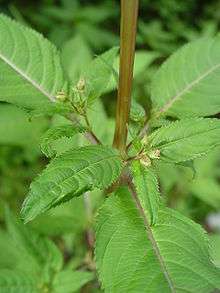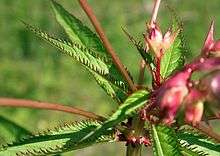Impatiens glandulifera
Impatiens glandulifera is a large annual plant native to the Himalayas.[2] Via human introduction it is now present across much of the Northern Hemisphere and is considered an invasive species in many areas. Uprooting or cutting the plants is an effective means of control.
| Impatiens glandulifera | |
|---|---|
| Scientific classification | |
| Kingdom: | Plantae |
| Clade: | Tracheophytes |
| Clade: | Angiosperms |
| Clade: | Eudicots |
| Clade: | Asterids |
| Order: | Ericales |
| Family: | Balsaminaceae |
| Genus: | Impatiens |
| Species: | I. glandulifera |
| Binomial name | |
| Impatiens glandulifera | |
| Synonyms[1] | |
|
List
| |
Etymology
The common names policeman's helmet, bobby tops, copper tops, and gnome's hatstand all originate from the flowers being decidedly hat-shaped. Himalayan balsam and kiss-me-on-the-mountain arise from the plant originating in the Himalayan mountains. Ornamental jewelweed refers to its cultivation as an ornamental plant.
The genus name Impatiens, meaning "impatient", refers to its method of seed dispersal. The species name glandulifera comes from the Latin words glándula meaning 'small gland', and ferre meaning 'to bear', referring to the plant's glands.
Description


It typically grows to 1 to 2 m (3.3 to 6.6 ft) high, with a soft green or red-tinged stem, and lanceolate leaves 5 to 23 cm (2.0 to 9.1 in) long. The crushed foliage has a strong musty smell. Below the leaf stems the plant has glands that produce a sticky, sweet-smelling, and edible nectar. The flowers are pink, with a hooded shape, 3 to 4 cm (1 1⁄4 to 1 1⁄2 in) tall and 2 cm (3⁄4 in) broad; the flower shape has been compared to a policeman's helmet.
After flowering between June and October, the plant forms seed pods 2 to 3 cm (3⁄4 to 1 1⁄4 in) long and 8 mm broad (1⁄4 in), which explode when disturbed,[3] scattering the seeds up to 7 metres (23 feet).
The green seed pods, seeds, young leaves and shoots are all edible. The flowers can be turned into a jam or parfait.[4]
The plant was rated in first place for per day nectar production per flower in a UK plants survey conducted by the AgriLand project which is supported by the UK Insect Pollinators Initiative. (However, when number of flowers per floral unit, flower abundance, and phenology were taken into account it dropped out of the top 10 for most nectar per unit cover per year, as did all plants that placed in the top ten along with this one for per day nectar production per flower, with the exception of Common Comfrey, Symphytum officinale.)[5]
Distribution
Himalayan balsam is native to the Himalayas, specifically to the areas between Kashmir and Uttarakhand. In its native range it is usually found in altitudes between 2000–2500 m above sea level, although it has been reported in up to 4000 m above sea level.[6]
In Europe the plant was first introduced in the United Kingdom where it has become naturalized and widespread across riverbanks.[6] Presently it can be found almost everywhere across the continent.[7][8][9]
In North America it has been found in the Canadian provinces of British Columbia, Manitoba, Ontario, Quebec, Nova Scotia, New Brunswick, Prince Edward Island and Newfoundland.[10] In the United States it is found on both the east and west coast, seemingly restricted to northern latitudes.[11]
In New Zealand it is sometimes found growing wild along riverbanks and wetlands.[12]
Invasive species
Himalayan balsam is sometimes cultivated for its flowers. It is now widely established in other parts of the world (such as the British Isles and North America), in some cases becoming a weed. Its aggressive seed dispersal, coupled with high nectar production which attracts pollinators, often allow it to outcompete native plants. Himalayan balsam also promotes river bank erosion due to the plant dying back over winter, leaving the bank unprotected from flooding.[13] Invasive Himalayan balsam can also adversely affect indigenous species by attracting pollinators (e.g. insects) at the expense of indigenous species.[14] It is considered a "prohibited noxious weed" under the Alberta Weed Control Act 2010.[15]
In the UK, the plant was first introduced in 1839, at the same time as giant hogweed and Japanese knotweed.[16][17] These plants were all promoted at the time as having the virtues of "herculean proportions" and "splendid invasiveness" which meant that ordinary people could buy them for the cost of a packet of seeds to rival the expensive orchids grown in the greenhouses of the rich. Within ten years, however, Himalayan balsam had escaped from the confines of cultivation and begun to spread along the river systems of England.[16]
It has now spread across most of the UK, and some local wildlife trusts organise "balsam bashing" events to help control the plant.[16] However, a study by Hejda & Pyšek (2006) concluded that, in some circumstances, such efforts may cause more harm than good. Destroying riparian stands of Himalayan balsam can open up the habitat for more aggressive invasive plants such as Japanese knotweed and aid in seed dispersal by dropped seeds sticking to shoes. Riparian habitat is suboptimal for I. glandulifera, and spring or autumn flooding destroys seeds and plants. The research suggests that the best way to control the spread of riparian Himalayan balsam is to decrease eutrophication, thereby permitting the better-adapted local vegetation, that gets outgrown by the balsam on watercourses with high nutrient load, to rebound naturally. The researchers caution that their conclusions probably do not hold true for stands of the plant at forest edges and meadow habitats, where manual destruction is still the best approach.
The Bionic Control of Invasive Weeds project, in Wiesbaden, Germany, is trying to establish a self-sufficient means of conserving their local biodiversity by developing several food products made from the Himalayan balsam flowers. If all goes well, the project will have it financing its own eradication.
In August 2014, CABI released a rust fungus in Berkshire, Cornwall and Middlesex in the United Kingdom as part of field trials into the biological control of Himalayan balsam.[18]
Some research also suggests that I. glandulifera may exhibit allelopathy, which means that it excretes toxins that negatively affect neighboring plants, thus increasing its competitive advantage.[19]
The Royal Horticultural Society and the Centre for Ecology and Hydrology recommend that pulling and cutting is the main method of non-chemical control, and usually the most appropriate.[20][21] Natural Resources Wales has used manual methods, such as pulling plants and using strimmers, to largely eradicate Himalayan Balsam from reaches of the River Ystwyth.[22]
 Himalayan balsam at Bank Hall, Bretherton, Lancashire, England
Himalayan balsam at Bank Hall, Bretherton, Lancashire, England Fruits
Fruits
References
- "The Plant List: A Working List of All Plant Species". Retrieved 7 April 2014.
- Webb, D.A., Parnell, J. and Doogue, D. 1996. An Irish Flora. Dundalgan Press (W.Tempest) Ltd. Dundalk
- Scott, R. 2004. Wild Belfast on safari in the city. Blackstaff Press. ISBN 0 85640 762 3
- "Gastronomie: Springkraut & Co.: Kräuterkoch Peter Becker macht aus Neophyten Salat". Badische Zeitung. 13 September 2011. Retrieved 21 May 2015.
- "Which flowers are the best source of nectar?". Conservation Grade. 15 October 2014. Retrieved 18 October 2017.
- Beerling, David J.; Perrins, James M. (June 1993). "Impatiens Glandulifera Royle (Impatiens Roylei Walp.)". The Journal of Ecology. 81 (2): 367–382. doi:10.2307/2261507. JSTOR 2261507.
- Pyšek, Petr; Prach, Karel (1995). "Invasion dynamics of Impatiens glandulifera — A century of spreading reconstructed". Biological Conservation. 74 (1): 41–48. doi:10.1016/0006-3207(95)00013-T.
- Scannell, M.J.P. and Synnott, D.M. 1972. Census Catalogue of the Flora of Ireland. Dublin. Published by the Stationery Office.
- Hackney, P. (Ed)1992. Stewart & Corry's Flora of the North-East of Ireland. The Institute of Irish Studies, The Queen's University of Belfast. ISBN 0 85389 446 9
- Clements, David R; Feenstra, Kathleen R; Jones, Karen; Staniforth, Richard (April 2008). "The biology of invasive alien plants in Canada. 9. Impatiens glandulifera Royle". Canadian Journal of Plant Science. 88 (2): 403–417. doi:10.4141/CJPS06040.
- "Himalayan balsam, Impatiens glandulifera Geraniales: Balsaminaceae". EDDMapS.org. Retrieved 20 November 2018.
- "Impatiens glandulifera". New Zealand Plant Conservation Network. Retrieved 20 November 2018.
- Greenwood, Phillip; Fister, Wolfgang; Kuhn, Nikolas (2014). "The potential influence of the invasive plant, Impatiens glandulifera (Himalayan Balsam), on the ecohydromorphic functioning of inland river systems" (PDF). Geophysical Research Abstracts: 2698. Bibcode:2014EGUGA..16.2698P. Retrieved 14 May 2015.
- Thijs, Koen W.; Brys, Rein; Verboven, Hans A. F.; Hermy, Martin (30 July 2011). "The influence of an invasive plant species on the pollination success and reproductive output of three riparian plant species". Biological Invasions. 14 (2): 355–365. doi:10.1007/s10530-011-0067-y.
- "Identification Guide for Alberta Invasive Plants" (PDF). Wheatland County, Alberta. 2017. Retrieved 28 July 2018.
- Mabey, Richard (25 July 2011). "Indian Balsam". Mabey in the wild. BBC. Retrieved 24 July 2011.
- "Wanted!: Himalayan Balsam". British Isles: A Natural History. The Open University. Retrieved 4 December 2009.
- "CABI releases rust fungus to control invasive weed, Himalayan balsam". cabi.org. CABI. 26 August 2014. Retrieved 17 May 2015.
- "Archived copy" (PDF). Archived from the original (PDF) on 31 May 2014. Retrieved 31 May 2014.CS1 maint: archived copy as title (link)
- "Himalayan Balsam". Royal Horticultural Society. Retrieved 2 June 2014.
- "Information Sheet 3: Himalayan Balsam" (PDF). Centre for Ecology and Hydrology: Centre for Aquatic Plant Management. 8 March 2013. Retrieved 2 June 2014.
- "Cyfoeth Issue 3 September 2013" (PDF). Natural Resources Wales. p. 6. Retrieved 12 June 2015.
External links
| Wikimedia Commons has media related to Impatiens glandulifera. |